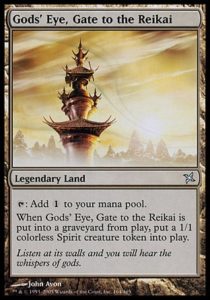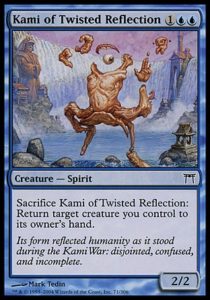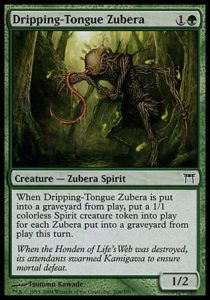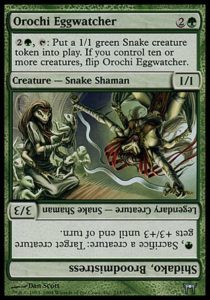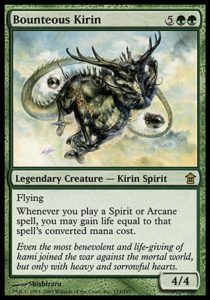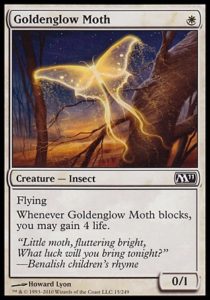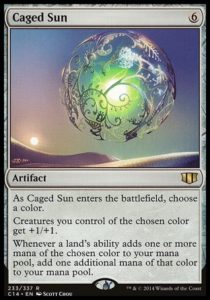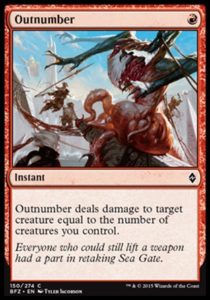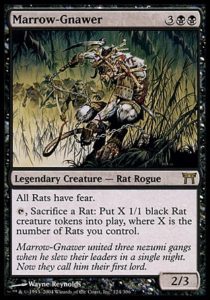If you’ve been following Blogatog these people few days, you’ve noticed that a common rotating conversation topic has reared its head again:
That’s right, people want to return to Kamigawa, what’s regarded as one of the worst designed and flavored sets in Magic’s history. This week, I’d like to say why I think that’s unlikely to happen, in a Standard-legal Magic set, excluding multi-world sets like Magic Origins. I don’t wish or mean to demean or criticize those who like Kamigawa, either aspects of it or all of it; I want to point out why I expect that a return is unlikely and what fans of Kamigawa can do to get their eventual return to the gods-river.
First and foremost, I acknowledge that Kamigawa suffered developmentally due to its immediately following Mirrodin, the biggest development failure this side of Urza’s Saga (though nevertheless a popular plane). I also acknowledge that Kamigawa had unusual and interesting flavor, an interesting Limited format, some cool mechanics (Ninjutsu, I’m looking at you-tsu), some popular busted cards (particularly Sensei’s Divining Top and Umezawa’s Jitte), and provided a slew of legends for Commander. In short, Kamigawa was not an abject failure across all spectra. It was, however, a failure across multiple major Magic metrics, and accordingly, is unlikely to be revisited.
Kamigawa had opaque flavor. It was far too true to its source material to be accessible to the majority of Magic players. Players respond well to their expectations of the lore being met, not the lore being perfectly accurately portrayed. Theros’ lore was far better received, not due to its close accuracy to Greek mythology (though it had Hundred-Handed One for those who wanted more obscure accuracy), but to its adhering to what players expect of Greek mythology (a Kraken to release, a pup Raised by Wolves). Kamigawa’s lore simply didn’t resonate with the majority of players.
Moreover, Magic sets aren’t supposed to be clear ports of an existing mythology or intellectual property. We don’t see sets like Arabian Nights anymore; Magic takes its own spins on Greek mythology, Celtic Lore, Gothic Horror, and swaths of Eastern Asia. Kamigawa was too faithful to its source material for it to meet the majority of players’ expectations and understanding.
Kamigawa had bad mechanics. While Ninjutsu is generally popular and Bushido (aka the Chub Toad mechanic) is straightforward (but weak and too linguistically tied to Japanese mythology to make sense on other planes), the rest of the mechanics weren’t so great. Flips cards are a mess; the art is almost as muddled as what side a flip card is when it’s tapped. Arcane is a neat mechanic that’s so parasitic it’s unusable outside of Block and Modern Masters. Sweep, Channel, and the wisdom mechanic are just bad mechanics. Offering and Epic have to be used so sparingly that neither may be worth keywording. There’s not much from Kamigawa we’ve seen again, other than Defender.
Kamigawa had unusual, but confusing artwork. While I hate to criticize a set for looking different from Magic’s norm (there’s a very soft spot in my heart for the look and feel of Lorwyn), Kamigawa was odd and somehow same-y looking. The spirits were visually all over the place and many were difficult to distinguish from each other. Flip cards, again, looked bad, confused players, and failed to elegantly communicate change over time (something which Level Up cards also struggled with).
The Legend gimmick flopped. It might not have been apparent to players, but every rare creature was legendary. This was largely invisible to the average player, meaning a major theme of the set was unknown (it’s why Mark Rosewater makes sure that a set’s theme, or at least its as-fan, in the case of Dragons of Tarkir, is at common).
There was such a glut of legendary creatures (and lands, and artifacts, and enchantments), that it was difficult to remember which one did what or which creatures with nonspecific names were in fact legendary. This overabundance of legends also made each legend less special: a small number of legends highlights important, or highly unusual characters from the world. A large number of legends muddles who is important and who is just filling out gimmick. Finally, it bears noting that legendary is a downside mechanic, even in the legends-matter world of Kamigawa.
It sold badly. Wizards is in the business of making an amazing game that makes money. Great sets sell well, because people want to play Magic with them more. Worse sets sell worse, because they make people not want to play Magic as much. Kamigawa sold poorly. You can blame it on power level, execution, flavor, mechanics, timing, or whatever else you want, but at the end of the day, it sold poorly and is one of modern Magic’s bigger failures. It represents several risks/experiments that Magic tried, which didn’t go well, and which it’s unlikely to repeat anytime soon.
Magic only visits two planes a year (barring supplemental sets and the rare multi-plane set like Origins); even if one in two blocks is a “Return to”, that’s not enough time to revisit everything (since at least one new plane is being added every year). Additionally, Wizards isn’t going to cycle through every set before returning to popular planes like Ravnica (or Innistrad, Zendikar, or Mirrodin); those are worlds that people don’t want to wait a decade before revisiting.
Why should Wizards work hard to revitalize a plane that was a comparative failure, one whose name alone is likely to turn away a sizable portion of its player base, when it could return to a plane which is likely to excite a large portion of fans?
I don’t deny that Wizards could make a more popular version of Kamigawa, but why ought they fight an uphill battle when working on a generally beloved plane is already a lot of work? What does rehabilitating an entire plane prove? Why does it justify the work? These are questions that I rarely hear answered by fans of Kamigawa, ones which need good, strong answers for Wizards to consider returning to the spirit world (rather than create a new Japanese-inspired world lacking the negative associations).
I don’t mean to deny that people liked parts or even loved all of Kamigawa. I know that you exist. I’m not saying that you have bad taste, appreciate bad mechanics, or are in any way wrong for liking Kamigawa. Kamigawa had objectively great parts and you’re subjectively allowed to love whatever you love, even if other people don’t share your feelings. However, you’re in the minority, and a small one at that. Even if your friends and other people online share your feelings, you’re not looking at a representative sample of players.
Perhaps things have changed over time. Perhaps people remember Kamigawa fondly now that it’s over a decade in the past. Perhaps many people who weren’t around for it love the flavor and Commander gifts. Perhaps the market research is so outdated that it no longer accurately reflects how players today feel about Kamigawa. However, there’s no evidence for this being the case, and even if it is, Wizards doesn’t have this information.
So, fans of Kamigawa, here’s what you should do (beyond continue to ask for Kamigawa): the next time that a product like Planechase 2012 or Modern Masters comes out (which features Kamigawa), or a Commander/Magic Origins has cards set on Kamigawa, buy the product (and participate in a Wizards survey, if possible). The best way for your voices to be heard is to vote with your wallets. Even if Kamigawa is never the focus of a Standard-legal set (and in the hypothetically infinite lifetime of Magic, anything is possible), its unique aesthetic and mechanics can return in supplementary sets, in callbacks, or in out-of-place references like Tamiyo, the Moon Sage. It’s far easier for Magic to take risks on smaller-print run products, and it’s far easier for your opinions to be known when your purchases constitute a larger percentage of total sales.
That’s it for this week. I apologize if I hurt or offended anyone: I admire the passion of every ardent support of Kamigawa, even if I’m skeptical that a return is nigh. We all eventually come to love something that most other people, for whatever reason, fail to share our passion for, and that experience isn’t fun. Hopefully my words have been of some utility, or failing that, haven’t enraged you. I encourage you to share your feelings in the comments below; I’d be happy to read and respond to them.
And, as always, thanks for reading.
—Zachary Barash
Zachary Barash has been playing Magic on and off since 1994. He loves Limited and drafts every available format (including several that aren’t entirely meant to be drafted). He’s a proud Cube owner, improviser, and game designer. He has an obsession with Indian food that borders on being unhealthy.

